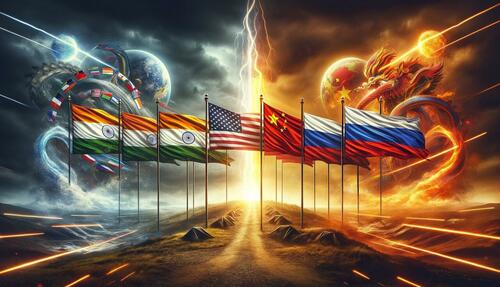The Trilateral Threat: India, Russia, And China
Authored by Andres Corr via The Epoch Times,
India, a country the United States and allies had hoped would be a bulwark of democracy against China, is becoming a problem.
The South Asian country is desperately poor, at just $2,400 gross domestic product (GDP) per capita in 2022. Yet it seeks to portray itself as an up-and-coming economic powerhouse.
It is increasingly authoritarian. Yet it wants to be seen as all things to all people, including the democracies.
Its prime minister, Narendra Modi, is prideful, highly nationalist, and has superpower aspirations.
That makes India’s relationship with more responsible powers, including the United States, increasingly strained, not least because of New Delhi’s too close relations with the world’s most dangerous dictators, Xi Jinping of China and Vladimir Putin of Russia.
New Delhi is involved in various international initiatives led by Beijing and is financially complicit in Moscow’s war against Ukraine.
The three countries cooperate through joint membership in Beijing-led organizations, including the military-focused Shanghai Cooperation Organization (SCO), which is the closest that the three have to an alliance system such as the North Atlantic Treaty Organization (NATO). All three find ideological common ground in their socialist histories and the promotion of a “new multilateral” international system that they seek to exploit in leading the developing world against “imperialism” and the “West.”
This developing trilateral threat is by no means a done deal because India is still a democracy among the wolves and could turn back from the hunt. While China and Russia have been strong allies for years, there is a crack in their relationship when it comes to India, which still seeks and needs Group of Seven (G7) approval, support, and markets.
Simmering border disputes between India and China in the Himalayas, and New Delhi’s private criticism of Moscow’s war with Ukraine, complicate the threat. Its veto power in the SCO could be useful to the democracies. Russia’s deteriorating international position as a pariah state forces it into the arms of both India and China, with New Delhi distancing itself, at least to some extent, from Moscow. Over the last two years, Mr. Modi has gone so far as to skip his annual in-person meetings with Mr. Putin.
India’s continued complicity with Russia’s war where it counts, however, stems from New Delhi’s violation of G7 sanctions against purchasing Russian oil above a price cap of $60 a barrel agreed in 2022. While the cap cost Russia almost $38 billion, India’s evasions pushed the price to about $70 a barrel. That increases the price of gas globally and gives the Kremlin more cash for killing Ukrainian civilians. The world has New Delhi to thank for its unprincipled position and the global pain it is producing.
India uses the extra money to fund imports of Russian oil, arms, and nuclear power plants. The two countries plan to jointly produce weapons, which means that India is importing Russian military technology that can be used in New Delhi’s border disputes with China. This must irk Beijing, but it likely prefers India to rely on Russian rather than American arms. At least then, if there is a Sino-Indian war, Beijing could lean on Moscow to halt arms exports to India, including critical spare parts.
European sanctions on Russia following the Ukraine war diverted its exports East. Now, approximately 90 percent of Russian oil exports go to China and India, with the former importing as much as 50 percent and the latter 40 percent. Without Indian purchases, China would have much greater trade leverage over Russia. So New Delhi plays a spoiler role for Beijing in the latter’s increasing economic dominance.
The more of a pariah Russia becomes, the more Moscow relies on New Delhi to moderate the power of Beijing, drawing the three ever closer into a more stable threat to the democracies. More fully separating India from China and Russia is thus an important U.S. foreign policy goal, which is why Washington is not more openly critical of the South Asian country. Yet more must be done as India has long been “anti-Western,” is increasingly autocratic, and U.S. business risks becoming reliant on its cheap labor in the pivot away from China. That risks increasing Indian political influence in Washington through the same kind of elite capture that previously insulated Beijing from criticism.
To mitigate these risks, the United States and G7 countries must impose economic penalties on India, as the many incentives of the past, including direct development aid, are underappreciated.
Our attempts at buying friendship apparently failed, and we are finally realizing that India is a fair-weather friend. Sanctions and tariffs will be needed to shift India away from Russia and China. No G7 country, including the United Kingdom, should execute new free trade agreements with India.
This tough-love approach to a fellow democracy should not be directed at India alone. Rather, new such policies should apply to any country that fails to fully cooperate with the United States and allies against existential threats from Russia and China, not to mention the trilateral threats that emanate from the complicity of third countries like India.
* * *
Views expressed in this article are opinions of the author and do not necessarily reflect the views of ZeroHedge.
Tyler Durden
Fri, 01/05/2024 – 03:30
via ZeroHedge News https://ift.tt/KgW89sP Tyler Durden
